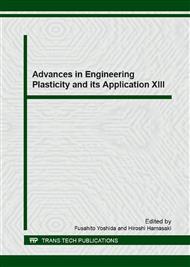p.489
p.495
p.502
p.511
p.517
p.523
p.529
p.537
p.542
The Refinement Algorithm of Blank Outline Based on One-Step Inverse Analysis
Abstract:
Blank dimensions and outlines can be obtained in one-step inverse analysis. Applying more accurate mesh will achieve more precise outlines while usually lead to the increase of computation time. To ensure operation efficiency, this paper proposes a new blank outline refinement algorithm based on one-step inverse analysis. Firstly, the initial configuration is obtained from the final configuration by one-step inverse analysis. Secondly, all outline nodes is projected to the nearest element in the final configuration. Thirdly, according to the position of projected nodes in the element, the coordinate of outline nodes in the initial configuration is achieved through mapping. Finally the number of outline nodes is increased in rounded corners, the coordinate of added nodes are calculated through interpolation. At last all outlines corresponding to characteristic lines of part surface are acquired. Using A-pillar as an example, outlines are calculated by the refinement algorithm and commercial software. It proves that under the same mesh quality, outlines obtained by refinement algorithm become more accurate and smooth, especially in rounded corner. The results can contribute to judge the rationality of blank shape and improve the final part forming property. This algorithm refines the accuracy of outlines and ensures the efficiency of one-step inverse analysis.
Info:
Periodical:
Pages:
517-522
Citation:
Online since:
December 2016
Authors:
Keywords:
Price:
Сopyright:
© 2017 Trans Tech Publications Ltd. All Rights Reserved
Share:
Citation:


